This is a blog post I wanted to write for some time now but the more I was thinking about it, the more difficult it seemed. This has to do with the term “non” in the title which means that it is difficult, if not impossible, to derive a universal guide/set of rules, about how people should behave or what to expect during in-water turtle observation. As we will stress many times in the following, each turtle is unique and should be treated separately. Guidelines of the type “one should stay at most X minutes with a turtle, keeping a minimum distance of Y metres” are difficult to be applied to all turtles. For instance, X minutes and Y metres might already be too long and too close for some individuals, or irrelevant for some others. Nevertheless, 8 years of underwater observations and almost 1000 sea turtle encounters allow me to say a few things, that have more to do with what should someone expect when she/he swims with turtles.
Let me stress that what follows has to do only with the loggerhead sea turtles encountered inside Laganas Bay, in the island of Zakynthos, Greece. Already in such a restricted geographical area, there is a great variability in the behaviour among individuals, that I would never dare to say that these (non)-guidelines apply to other areas in the world where also other sea turtle species can be observed underwater.
So this post has following the general purposes:
- To give an idea on what kind of sea turtle behaviours can somebody observe, something that will help on
- keeping a low degree of disturbance to the animal, and
- having a greater and more thorough experience from the observer’s part.
- To serve as a personal reference for me, when people are asking about this matter.
Is it ok to swim with turtles?
Let us start with this basic question, even though with so many encounters in my pocket I am not the most objective person to answer this. In principle, philosophically speaking, I think there is nothing wrong with two different species meeting randomly. One should keep in mind, that during their lives, sea turtles have probably met with far more dangerous animals than a creature who can barely keep its breath for more than a minute and is a very slow swimmer. In fact, turtle-turtle encounters many times have far more impact than turtle-human encounters, and sometimes, one can see specific individuals be more cautious when another turtle approaches rather than a human.
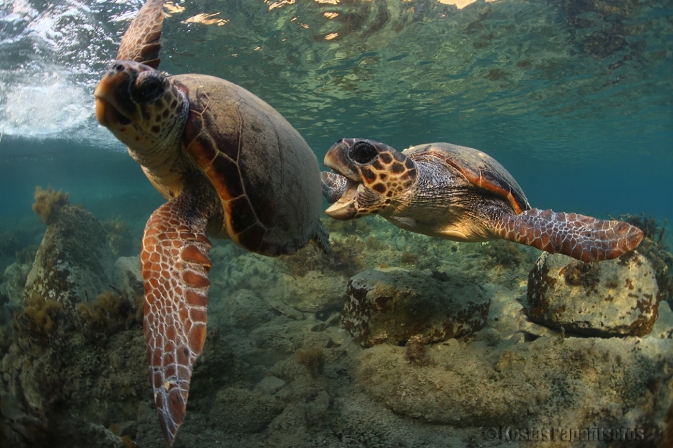
In order to better answer that question pragmatically, one should examine two things: (i) what is the impact, if there is any, to specific individuals, and (ii) if there is any impact, is the population endangered enough, such that this impact will affect significantly their numbers somehow. For the second point, recently IUCN classified the Mediterranean loggerheads as least concern, which is the lowest category possible. Even though terms like under extinction, or rare species are no longer representative for characterising the species, the term conservation-dependent was suggested as more appropriate, and hence the existence of any potential impact between turtles and humans should be still investigated (first point above). I will argue that in Zakynthos, for the majority of the individuals if there is any impact this is minimal. We note that we are not referring here to the boat-based turtle spotting industry that exists in Zakynthos (for that see this study) but we are restricting ourselves to underwater observations, e.g., snorkelling.
What kind of turtles can somebody see in Zakynthos?
Zakynthos is one the main reproductive sites for the Mediterranean loggerhead sea turtles. However apart from the regular reproductive migratory population, Zakynthos hosts a number of resident individuals that live and forage on the island all year around. In particular we have the following categories:
- Actively reproducing migratory males. Seen any time between February and June, see here, here and here, as well as references therein.
- Actively reproducing migratory females. Seen any time between March and beginning of September, see same references as above as well as here.
- Actively reproducing non-migratory (residents) males. Seen all year around (see here as well as personal observations).
- Immature turtles (juveniles) of unknown sex, residents and (?) migratory. Seen all year around (personal observations).
Interestingly a small number of juvenile green sea turtles have also been spotted over the years (see here for example). But if one sees one, he/she should consider him/herself extremely lucky for these few seconds before it disappears instantly in full speed! Notably, no resident actively reproducing females have been observed so far on the island.
As far as behaviour is concern and response to human presence there are differences not only between the 4 above categories but also within them. Let us briefly describe first what sea turtles do normally.
- During the mating season (March-June), actively reproducing males, migratory and residents, are looking constantly for females to mate, swimming most of the time. The typically get involved in interactions, aggressive or not, with other males and females.
- Resident males, after the end of the mating season, will typically start foraging.
- Actively reproducing migratory females, during mating season they can be seen mating/interacting with males, basking/resting in warm waters, actively swimming towards warm patches of water, as well as interacting with other females aggressively or not, presumably competing for optimal resting places. After mating season and as the water temperature rises, they become more lethargic and they spend a great amount of time resting on the seabed, generally avoiding aggressive interactions with other individuals. Some females also invest on cleaning behaviour, see for instance our latest paper. Most of the females will leave the island by the middle of August.
- Juvenile turtles spend most of their time foraging. We know very few about their movements but some of them do exhibit long term residency (personal observations).
A relevant fact that we are going to refer to later on, is that, for nesting females, water temperature seems to be crucial for their levels of activity: turtles are more active during mating season/beginning of nesting season and their activity is decreased after end of June when water temperature has increased considerably. This has been confirmed with the use of accelerometers but it is also very easily noticeable by direct observations. The following paragraph from the above linked paper puts it nicely:
“Activity levels were not constant throughout the season, being impacted by both ambient water temperature and female reproductive status. In cold water at the beginning of the nesting season, high levels of activity suggested that females behaviourally thermoregulated by seeking out warm water patches along the shoreline. Interactions with male turtles (courtship and/or avoidance) may also explain this high level of activity. As sea temperatures warmed up and the amount of energy devoted to reproduction probably increased, the turtles spent more time resting during long sequential flat-bottomed dives, and reduced any unnecessary locomotory activity.” [Source: Fossette, Schofield, Lilley, Gleiss, Hays: Acceleration data reveal the energy management of a marine ectotherm during reproduction, Functional Ecology 2012]
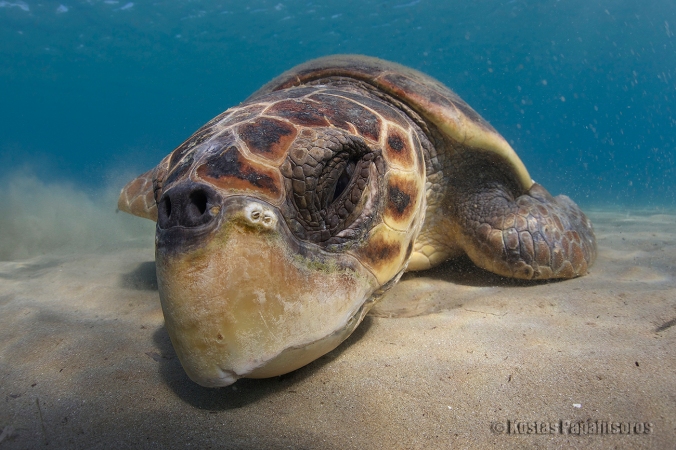
We should also note here that actively reproducing female turtles seem to possess a natural stress-reduction mechanism during their reproductive period that helps towards a maximal reproductive output. This seems to help mitigating the effects that stressing factors might have in the reproduction process, like interaction with other turtles, shark attacks (in Australia), or in our case interaction with other species. Tim Jessop has worked a lot in that area, see some relevant papers of his, here and here (also in Biology of Sea Turtles volume 1, Section 5.5.7.2)
Summarising, here are a few resources regarding in-water loggerhead behaviour (by direct observations) in Zakynthos (some links are the same as above):
- Systematic classification and analysis of the behaviours using in-water observations, (journal paper).
- Female-to-female aggressive antagonistic interactions (journal paper).
- A look into interactions at cleaning stations and foraging sites (poster).
- Cleaning station use inside Laganas Bay, Zakynthos, (journal paper).
- General in-water behaviour video.
- Cleaning station video.
- Article about in-water observation in SWOT (the State of the World’s Sea Turtles) report. Whole issue available here.
After summarising the general in-water behaviour of Zakynthos loggerheads, we will now focus on their behaviour upon meeting with humans underwater.
How do turtles react to the presence of humans underwater?
We are now coming to core of this article. This is a subject that so far has not been studied systematically and in depth (even though this relevant study about Hawksbill turtles in Honduras exists), so what follows is mostly a result of personal observations. Again, I cannot stress enough the variability that characterises this issue.
I did a first attempt to classify the different responses to human presence in a study presented in the International Sea Turtle Symposium in Turkey, 2015. There, I introduced 4 different categories of behaviours, depending on the degree of disturbance that the turtle exhibits upon encounter with humans:
- Category 1: Great degree of disturbance, typically characterised by immediate abandonment of the site in high swimming speeds.
- Category 2: Moderate disturbance, characterised by abandonment of activities (e.g., foraging, resting), accelerating when being approached, performing sharp turning movements.
- Category 3: Slight disturbance. Here no significant signs of disturbance are shown, but the behaviour cannot be yet classified in the next category. The turtle does calm but avoiding movements when the person approaches too close.
- Category 4: No disturbance. The turtle shows no disturbance signs, almost indifference to the human presence. Examples include, foraging or resting, with these activities not being interrupted even when the person approaches really close (in the scale of centimetres!).
For a more detail description see this video, that accompanied the symposium presentation. We will analyse a bit more in depth the two extreme categories, 1 & 4:
Video showing turtles that exhibit great degree of disturbance (Category 1):
You notice in the video above that the second turtle was actually surprised and got scared away. When someone encounters a foraging turtle, it is generally a good idea not to approach it from behind, but to let the turtle see him/her first. This is one of the few rules we can say here: Turtles do not like surprises! Turtles as small as the third one in the video seem to swim away immediately. Some green turtles that have been sighted in the bay, and have similar size, have also shown analogous behaviour.
There is no reason to try and give guidelines for this kind of behaviour. A turtle in full speed will disappear out of someone’s sight in seconds and it is pointless to try to follow it. Note that this behaviour can be pretty much exhibited by all type of turtles, male, females, juveniles while performing any kind of activities. There seem to be some exceptions. A mating pair is too bulky for the female to swim away in full speed (not too much experiences with mating pairs though). Foraging turtles will also rarely swim away like that, especially those that forage for molluscs in the sand. Actually the foraging turtle in the video was just surprised and on subsequent, more careful approaches, exhibited more like a category 3 behaviour. Thus it can also happen, but not so often, that a turtle exhibits different types of behaviours during the same encounter. Nesting female turtles can exhibit this behaviour at any time, but it is less likely to do so, as the water temperature rises as we discussed above. In fact, seen a turtle in July-August exhibiting this kind of behaviour, with no apparent signs that she is a nesting female (e.g. external tags placed by Archelon), should put you into thoughts that she might not be reproductively active at that moment, or that it is a juvenile. Males during mating season are also possible to react like that, but they can also have a more passive reaction, sometimes even being aggressive (personal communication with Gail Schofield).
Summarising, Category 1 turtles might likely be:
- Surprised turtles
- Females during mating/beginning of mating season when water temperature is low
- Males during mating season
- Very small turtles
- Possibly turtles that have never or rarely seen a human before (difficult to verify)
As we have stressed many times, no strict rules apply anywhere here and in principle any type of turtle might exhibit this behaviour.
Video showing turtles that exhibit no disturbance (Category 4):
I never cease to be surprised by turtles that exhibit this category’s behaviours. Sometimes, it is remarkable how close you can approach an individual and it still acts like you are invisible! Again behaviours of this category can be observed in all types of turtles. However, even though the sample size is small, it occurs particularly often to foraging turtles (males, juveniles), especially those who are foraging for molluscs in the sand.
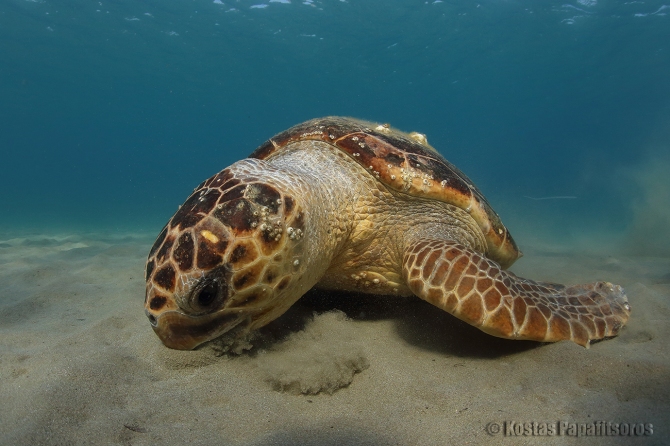
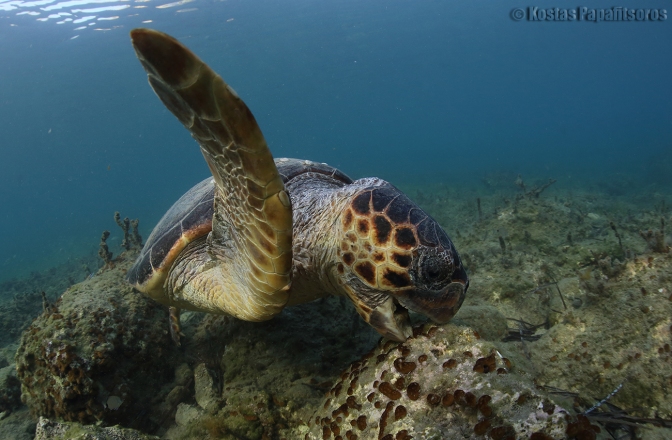
As we also mentioned previously, the behaviour of nesting females after the middle of the nesting season can be also quite often classified as Category 4, especially when they are resting on the sea floor. Even when they have their eyes wide open (as we saw at the beginning of the first video), someone can approach really close with no reaction. Sometimes, turtles (females or not) will even rest in the presence of humans (swimming first and then resting), an act, which I consider a combination between non-significance disturbance and urge to rest in order to minimise energy that will eventually go into reproduction. The stress-reduction mechanism we discussed earlier might also play a role on that.
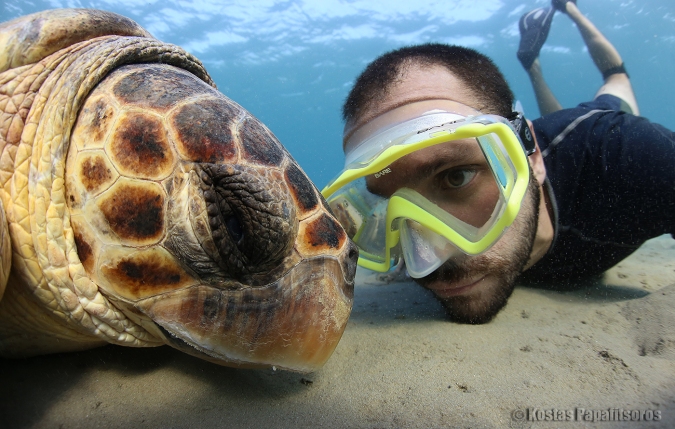
More rarely, some turtles will exhibit Category 4 behaviour, even when they are just swimming. In that case, even when you go directly in front of them, they will just stop for a while, look at you and swim slowly overpassing you. A very representative example is Hercules, a male loggerhead, one of the most “relaxed” turtles around.
Having discussed more in depth Categories 1 & 2, we must note that on average, during the nesting season, nesting females are more likely to exhibit a Category 2 or 3 behaviour, probably trying to achieve an optimal balance between saving energy and avoiding any interactions with other individuals (humans or conspecifics). In the aforementioned study presented in Turkey, I classified all the encounters that I had during 2014 (n=64):
- Category 1 (great degree of disturbance): 24% of all encounters (n=15)
- Category 2 (moderate disturbance): 42% of all encounters (n=27)
- Category 3 (slight disturbance): 20% of all encounters (n=13)
- Category 4 (no disturbance): 14% of all encounters (n=9)
The fact that when considering only nesting females, 72% of them classified as Category 2, confirms what was mentioned in the previous paragraph. Interestingly, in most cases same individuals exhibited behaviour of the same category over different encounters. In fact, if in the list above, we consider individuals instead of encounters, the percentages will not change too much (but that should be seen as a coincidence at it depends how many times a specific individual was encountered). However, this fact brings us to the next point.
The “personality” factor
By this we mean the consistent exhibition of the same type of behaviour of a specific individual, not only within the same season but over different years as well. We will dare to call that personality of the turtle even though zoologists and biologists are very cautious to use this term. This observation is particularly notable in the long term resident turtles for some of which I have underwater behavioural data for up to 7 years now. For example, some turtles are consistently foraging in almost every single encounter over different years, exhibiting similar responses upon approach (from indifference till high disturbance signs). Others, seem to be more reluctant to the human presence over the years (which supports the thought that new recruits are more easily scared) and others despite being long term residents exhibit behaviour which is more like 1 or 2. There are also a few examples of nesting females seen year after year (mostly after 2 or 3) that still exhibit similar behaviours and responses. So someone should always remember the following non-scientific statement (but nevertheless true):
Independently of time of the year, water temperature, type of turtle and reproductive status, every individual has its own distinct personality which, in addition to the factors above, also drives its behaviour and response to human presence.
To put that into context, it has been very useful for me to know the personalities of a number of turtles in Laganas Bay and adjust my own movements to achieve optimal observation and photo opportunities on one hand, and minimum disturbance, on the other. For instance, when somebody is observing Lucretia above, when she is focusing on foraging, she can be approached at a very closed distance, but when she stops chewing and lifts her head up, she can be very easily annoyed. At that point, I try and keep my distance.
Observation times vs different exhibited behaviours
In the study presented in Turkey, I also made the following graph that shows the time I spent in every turtle encounter also in relation to the 4 behaviour categories:
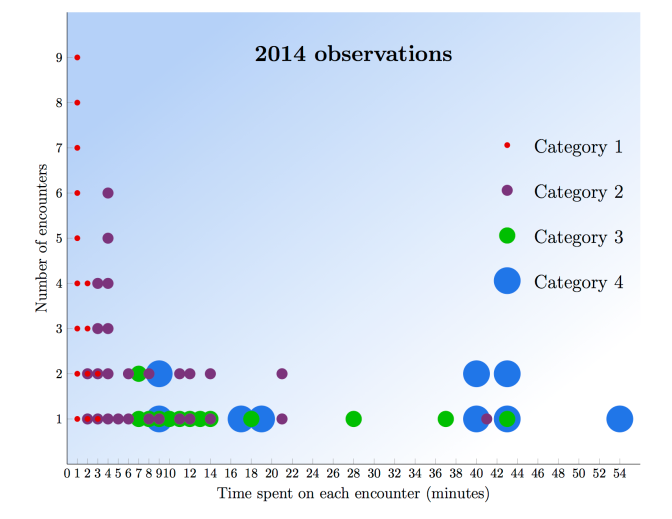
It is easily seen that the behavioural response of the turtle clearly affected my observation times. This results from the strategy approach as close and for as long as the turtle permits. In particular the average observation times where 1.5 minutes, 8.8 minutes, 16.7 minutes and 30.4 minutes for turtles that belonged to Categories 1, 2, 3 and 4 respectively. Notice the outlier of Category 2, with 41 minutes observation time. That was the well-known Bertha, followed from a certain distance.
Generalising a bit let us have a look at observation times for the last 8 years (2010-2017) without however classifying the encounters in different categories (that requires quite a bit of time and it is beyond the purposes of the current post)
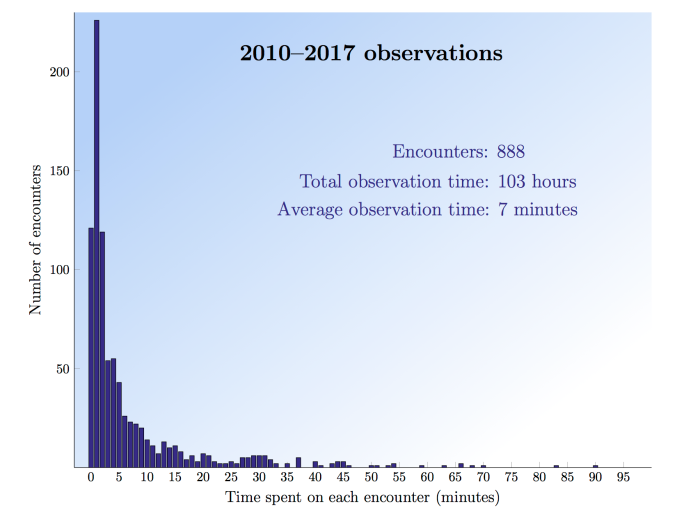
A few words are in order for the graph above. First of all I was personally surprised that around 50% of my encounters lasted approximately one minute or less. These encounters certainly include turtles of Category 1 but also individuals I had little interest to stay with, for one reason or the other. Interestingly 81% of the encounters lasted 10 minutes and less. Certainly, when you are in the water it seems longer than that! Moreover, the majority of turtles that were observed more than a hour, were foraging turtles, with the longest observations 90 minutes, 83 minutes and 70 minutes being turtles foraging on molluscs (90 & 70 was the turtle named Eva, shown in the photograph above). It is clear that long observations for these type of turtles has minimal if not no effect at all. However, in order to have a more complete view and try and answer the initial question about the impact on the population, the following questions need to be answered:
- Do other snorkelers follow a similar strategy regarding observation times?
- How often and for how long, are specific individuals observed by humans in a given season, especially for nesting females?
- Does underwater observation have an effect on the reproductive output of nesting females and in what extent?
For the first question, my feeling is that most snorkelers, in general would stay less than me with a turtle, but this is something that should be investigated.
For the second question, given that the majority of the bay is a snorkeler-free zone (a typical human will only stay in the shallows and tourists aggregate in specific spots), also together with the fact that nesting females move around a lot, I would say that the accumulative time they spent with a human is relatively low. However, this is also something that should be investigated in detail. The fact that females are actively swimming towards warm patches of water, is also relevant for their encounter with humans. In May and early June, the females tend to aggregate in the very swallow parts of the Bay (knee depth) where the water becomes warmer especially in the afternoon (personal communication with Gail Schofield). In these situations, they are more likely to be approached by people.
We should mention that low probability of an encounter with human, is probably not true for some residents that forage in a highly touristic area (Agios Sostis), but there, I would consider the real anthropogenic stressor to be the intense and largely uncontrolled presence of boats, turtle spotting or private hired ones, some of them exceeding by far the 6 knot speed limit, that by law exists in Laganas Bay. In fact, two of the residents seem to have recently suffered minor injuries caused by boat propellers. Illegal fishing and feeding also cause problems in that area. It is generally a good idea for snorkelers not to approach a group of such boats for everyone’s safety. So here’s another general advice: avoid the crowds.
Something that I have a few data on, is whether observation by a large group of people, lead the behavioural response to a lower category (e.g. from Category 3 when the turtle is observed by one snorkeler, to Category 2 when observed by a group). My initial feeling is that this is the case but it needs to be looked at more carefully.
For the third question, again we have no clues, however given the stress-reduction mechanisms it is more likely that a few minutes of daily underwater observation have no effect at all, rather than having one. Of course observation should be regarded here as a mild one, it goes without saying that for instance, grabbing/feeding turtles should be avoided.
Summary
We provided an overview of different sea turtle behaviours and responses to the presence of humans and how these are influenced by a variety of factors, such as sex, water temperature, reproductive status, performed activities at the time of the encounter etc. We stressed many times the variability that characterises these behaviours both within and among turtles of the same status (personality factor). We argued that given our current knowledge, there is little or no risk to the population linked to (mild) underwater encounters by humans.
So, get in the water, act sensibly and with respect, and live the magical experience of being underwater with a sea turtle.
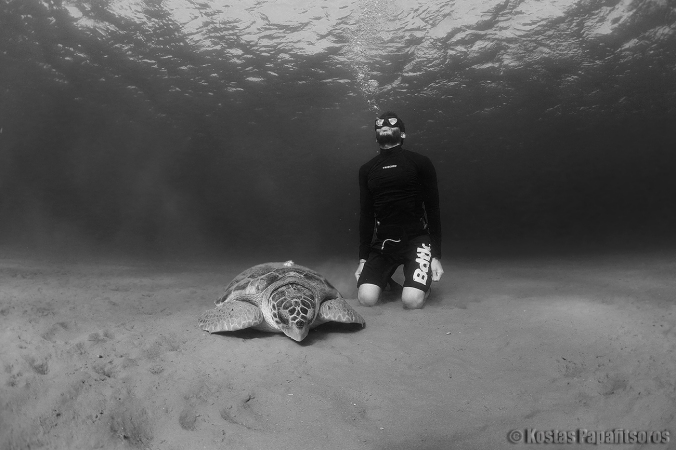
Many thanks to Gail Schofield for having useful discussions and providing constructive comments on this post.
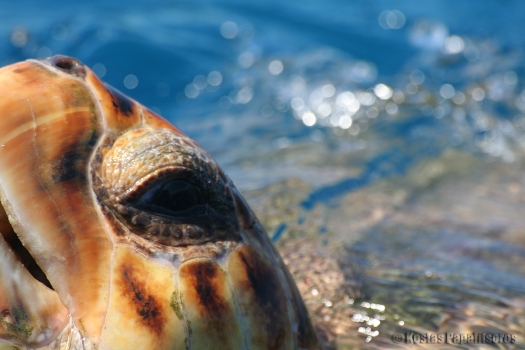

Dear Kosta,
Regarding your attempt to categorize turtles according to their response to the human presence, I believe you should try to categorize human behaviors related to turtle watching activity : Thus you can elaborate a more complicated and elaborated system that will allow you to better understand how easily you can impact the turtles’ behavior. As an example let’s consider that there are four categories of observers (snorkelers /divers):
1. The nervous/unsure one (the one with abrupt movements and doing unneeded noise)
2. The patient one (the one keeping a distance and waiting for the turtle to approach him, if possible)
3. The egocentric one (the one trying to make a selfie with turtles, the one trying to catch a turtle because he considers that he is the king of animals…)
4. The conscious scientist (the one trying to mitigate the impact of the potential disturbance for research purpose)
Just consider that turtles are marine animals and humans are not and you can easily understand that the majority of observers (let’s say 70 %) belong to the categories 1 and 3. It means that their potential (negative) impact should be aggregated to the response level of turtles belonging to categories 1, 2 and 3. Keeping in mind the assumption that the majority of observers could potentially make the turtles feel more unsecure /more reactive and taking into account that, as a snorkeler or diver you are a potential intruder/predator, you understand that it’s crucial to deliver a message to readers that can’t be misunderstood and misinterpreted. So, even if your survey could be of interest in order to understand turtles’ response to human (underwater) presence, you should ensure that no photo used deliver the opposite message, especially when we know that photographers often cross the red line (the common sense I mean) in order to get the most impressive pictures. So I hope that the photos you show are only for a scientific purpose and not for promotion purpose. But still I believe that they deliver a wrong message (especially the one “selfie” with a turtle) with potential very negative consequences.
Best regards.
Laurent Sourbès
LikeLike
Hi Laurent,
This is a very interesting point. Indeed I did not consider here at all the different behaviours that a snorkeler exhibits and indeed there are many categories here as well, some of them you mention yourself. The main reason for that was that I don’t have many data/experience on what the other people do and how different turtles react to the 4 categories of snorkelers that you mention (if indeed they react differently). So these turtle responses, together with all the percentages, are related only to my behaviour, which I wouldn’t include it to any category above. As I have stressed, I follow a strategy “wait and judge” and “approach as close as and for as long a turtle permits”. I would assume and urge everyone to follow such an approach, especially if they have no experience at all.
Regarding selfies, I stressed many times, both in the blog post and in Facebook that people should not think that they can achieve that with any turtle. I think if someone isolates the specific photos and repost them somewhere else, yes, the wrong message can be passed. But these photos should be regarded as part of a whole message. It is not a lie that sometimes you can take selfies with no impact at all. But it is also true that the majority of the times, this is not possible and some lines are crossed. People will always want to swim, see, take photos of turtles. This article has also the purpose to make them understand that sometimes it is possible to do that sometimes it is not.
LikeLike
Dear Laurent and Kostas,
although compared with you I have a lack of knowledge (I swim with the turtles only the last four years), allow me to share my personal experience of swimming with them. Sea Turtles and especially Caretta caretta is a unique species, in the water looks like it is flying in an imposing way and helps you to calm down and to enjoy the moment. It is true, that most of us wants to catch beautiful moments with our camera and for me this is not condemnable. However, the way we do that is an issue, as Laurent said, unfortunately, there are not only observers who respect the individuality of the sea turtle but also those who only care about a good selfie. For me it is easy to understand when I cross the red line, sea turtle will show it to me with her reaction swims faster, goes deeper and stays under the water much more than I or anyone else can. So is almost impossible to have even a photo from distant if she/he is not in a mood and even if I don’t have statistics as Kostas has I know that in four years, this year for first time a manage to come close with a sea turtle named Eva. Most of the times individuals run away or go deeper and in some cases if the observer is not experienced and especially if he is an observer Category 1 or 3 sea turtle might attack him and bite him. So, for me the main problem is not if the people wants to have a closed photo like the one of Kostas, the main problem is that the lack of knowledge of how to swim with a sea turtle can be dangerous for you. In closing, I would like to say that articles like this one helps people like me, you can decide in which category I suit, to better understand the behavior of a sea turtle and not to be inadvertently annoying.
LikeLike